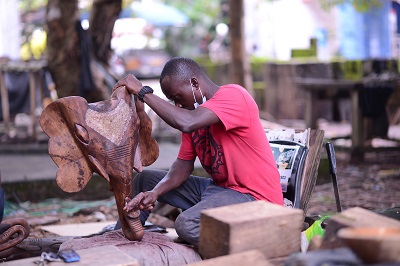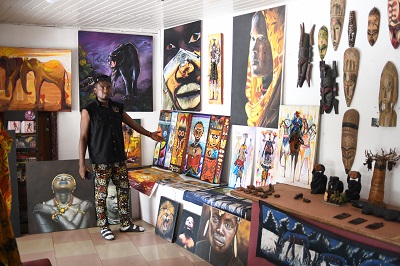Lost art: COVID-19’s devastating impact on Ghana’s arts

The role of artists is to express themselves and tell a certain truth about their society in their work.
Art does, and always will, offer insights into who we are and what we are experiencing, as individuals and as a society as a whole.
But art is a money-making venture, and with the world effectively at a standstill, gallerists, dealers, and the artists they represent are essentially operating without one of their greatest sales tools, that is the human connection.
With the COVID-19 pandemic in place, the conventional process of communicating an artist’s vision and enticing collectors, institutions, and gallery goers to buy into it both figuratively and literally has been dormant.
In an interview, Mr. Philip Opuni, a fine artist at the Kumasi Cultural Centre in the Ashanti Region, said the pandemic had shuttered his business
“The principal effect, of course, is not being able to be present physically in front of a piece of work,” he said.
He again said that, visiting the museums, galleries, and having studio visits with artists and interacting with artwork personally was integral to the industry, especially during traumatic moments.
He said that, moments like the one we are in now, ie rising unemployment, instability, and uncertainty, could have an effect. “Many are less concerned with starting or building collections than they are with securing the basic necessities in order to survive.”
“I am not worried about the negative impact of COVID-19 on art, I am, however, worried of the people who count on a functioning art industry to make ends meet and whose livelihood is dependent on museums, galleries being open, on shows being guarded, maintenance being performed, art works being shipped, and sales being made,” he added.
One Mr. Harrison also said, artists were concerned with how long this pandemic was going to last, especially as social distancing was a serious impediment to the process of production.
He said, mass job losses, venue closures and most significantly, the threat of contracting the disease were factors that the art industry wasn’t prepared to face. “The economic hardship might have similarities, but the effect on how we look at art, and how we function as an art community has fundamentally changed,” Mr. Harrison explained.
Ms. Philomina Awudu, an artist at the Tamale Cultural Centre said, the pandemic was changing the way we valued art, which is the biggest question we do not have an answer to.
There is a world where by looking only digitally at art, I can imagine lasting effects on the perception and taste of art. One can ask: Will artwork that is virtual dictate our taste?
“Will it determine the trajectory of the art of the future?”, she asked.
She said, the outbreak of COVID-19 had also led to deeper introspection. Artists, by and large, were required to hit the pause bottom, which revealed a sense of clarity that perhaps wouldn’t have been apparent if the industry continued business as usual.
Reporters, political pundits, health experts, and commentators are all spewing facts and figures, debating over the right course of action to take to move the nation forward. Artists, on the other hand, have the ability to offer a different kind of vision of the future.
Ms Philomina said, “Art is the soul of any civilised society, and I love my part in it; but I am no expert in the business of art, only creating mine, but the current state of the art world, like that weekend at various cultural centres in the country, is cloudy.”
From Geoffrey Buta, Kumasi.
















